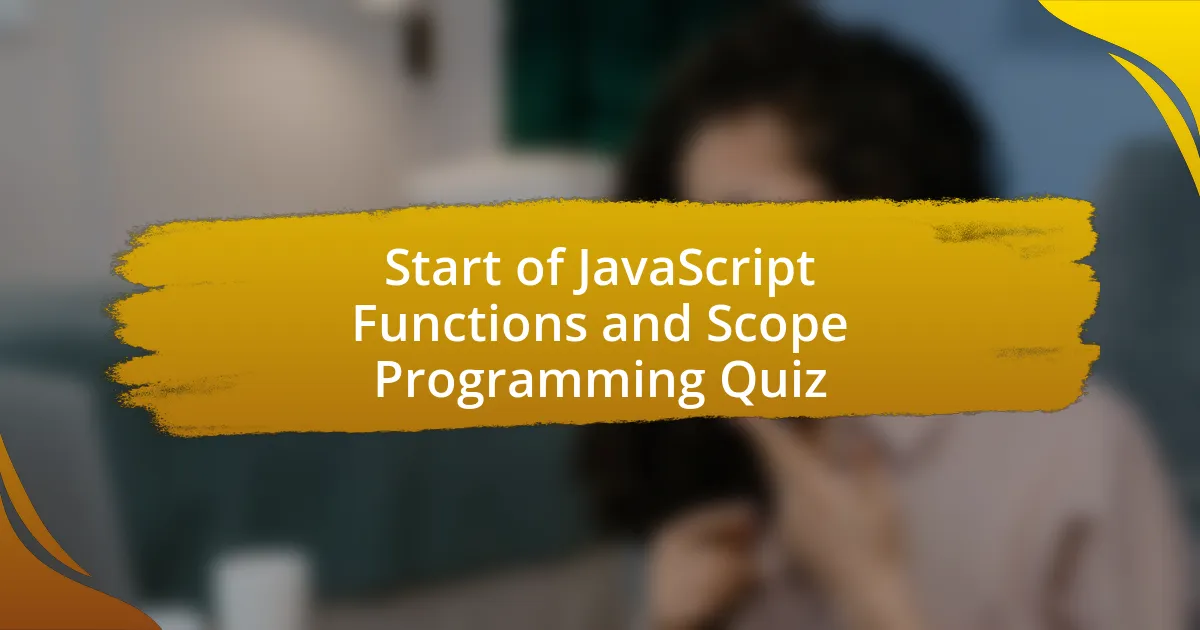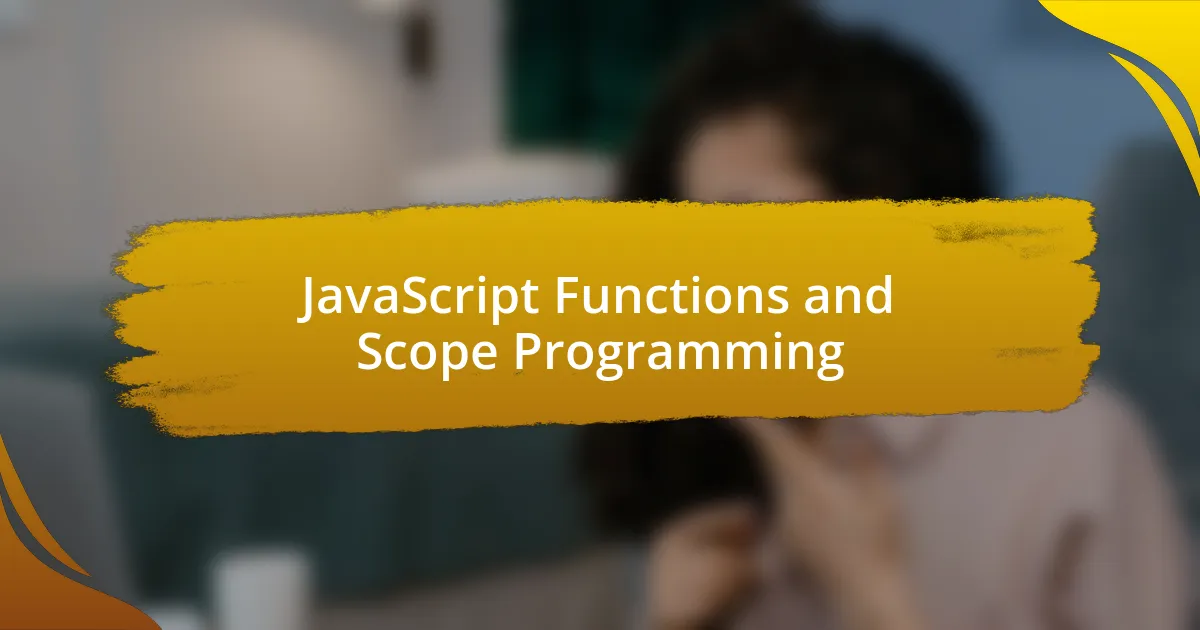
Start of JavaScript Functions and Scope Programming Quiz
1. What is the scope of variables declared with the var keyword?
- Block scope.
- Function scope.
- Local scope.
- Global scope.
2. Which keywords were introduced in ES6 to provide Block Scope in JavaScript?
- inline and block
- static and private
- var and global
- let and const
3. Where can variables declared inside a { } block be accessed from?
- Only from global scope.
- Within that block and its nested blocks.
- From anywhere in the program.
- Only from outside the block.
4. What happens to local variables in JavaScript when a function is completed?
- They are garbage collected.
- They are moved to global scope.
- They remain in memory.
- They can be accessed later.
5. What is the scope of variables defined inside a function in JavaScript?
- Global scope.
- Local scope.
- Undefined scope.
- Block scope.
6. How do global variables differ from local variables in terms of scope?
- Global variables can only be accessed within their defining block, while local variables can be accessed anywhere.
- Local variables are accessible from anywhere in the code, while global variables are only accessible within their defining function.
- Local variables are accessible across different functions, while global variables are limited to their local scope.
- Global variables are accessible from anywhere in the code, while local variables are only accessible within their defining function or block.
7. What is the difference between var, let, and const in terms of scope?
- var and let have block scope, const has function scope.
- var has block scope, let has global scope, const is undefined.
- var has function scope, let and const have block scope.
- All keywords have global scope.
8. Can you access a variable declared with let inside a nested block?
- No, you cannot access a variable declared with let inside a nested block.
- Yes, you can access a variable declared with let inside a nested block.
- Yes, but only in the same function scope.
- No, let variables are not accessible at all.
9. What happens if you declare a variable with var inside a block?
- The variable will be undefined outside the block.
- The variable will only exist within the block.
- The variable will throw an error.
- The variable will be accessible outside the block.
10. How do you declare a variable with block scope in JavaScript?
- Using function.
- Using var only.
- Using let or const.
- Using global.
11. What is the lifetime of a variable declared with var?
- The lifetime of a variable declared with var lasts until the page is refreshed.
- The lifetime of a variable declared with var is until the end of the current script or function execution.
- The lifetime of a variable declared with var is limited to the block it is declared in.
- The lifetime of a variable declared with var is confined to the loop in which it was created.
12. Can you declare a variable with var inside a function?
- Yes, but only outside of any blocks.
- Yes, you can declare a variable with var inside a function.
- No, you cannot declare a variable with var inside a function.
- No, it can only be declared globally.
13. How do you ensure that a variable is not accidentally overwritten in JavaScript?
- Declaring the variable outside all functions.
- Using const to declare the variable.
- Assigning a value inside a block.
- Using var to declare the variable.
14. What is the difference between let and const in terms of reassignment?
- const allows some reassignment, while let does not.
- const allows reassignment, while let does not.
- let and const both allow reassignment.
- let allows reassignment, while const does not.
15. Can you reassign a value to a variable declared with let?
- Yes, but only if it is within the same function.
- Yes, you can reassign a value to a variable declared with let.
- No, once assigned, the value cannot change.
- No, you cannot reassign a value to a variable declared with let.
16. What is the purpose of using const in JavaScript?
- To declare variables with function scope.
- To prevent reassignment and ensure immutability.
- To allow variable hoisting and reassignment.
- To define global variables in JavaScript.
17. How do you declare a constant in JavaScript?
- Using let.
- Using define.
- Using var.
- Using const.
18. What happens if you try to reassign a value to a constant declared with const?
- It will create a new variable.
- It will assign the new value.
- It will ignore the new value.
- It will throw a TypeError.
19. Can you declare a constant inside a function?
- Only global constants can be declared, not local ones.
- Yes, you can declare a constant inside a function.
- No, constants cannot be declared in functions.
- Yes, but it must be at the global scope.
20. What is the scope of a variable declared inside an immediately invoked function expression (IIFE)?
- The scope of a variable declared inside an IIFE is global.
- The scope of a variable declared inside an IIFE is accessible across all functions.
- The scope of a variable declared inside an IIFE is limited to the surrounding block.
- The scope of a variable declared inside an IIFE is local to that function.
21. How do you create an IIFE in JavaScript?
- Using `function() { … }()`
- Using `{function() { … }()}`
- Using `async function() { … }();`
- Using `(function() { … })();`
22. What is the purpose of using an IIFE in JavaScript?
- To create a local scope and avoid polluting the global namespace.
- To make variables global and accessible anywhere.
- To enhance the readability of the code only.
- To improve the performance of JavaScript execution.
23. Can you access a variable declared inside an IIFE from outside the IIFE?
- Yes, you can access a variable declared inside an IIFE from anywhere.
- No, you cannot access a variable declared inside an IIFE from outside the IIFE.
- Only if it’s declared with var you can access it from outside.
- You can access it as long as you call the IIFE first.
24. What is lexical scope in JavaScript?
- Lexical scope is the same as dynamic scoping in JavaScript.
- Lexical scope is determined by the runtime environment of the program.
- Lexical scope refers to the visibility of variables only within the current function.
- Lexical scope refers to the way variables are looked up based on their position in the code.
25. How does lexical scope work in JavaScript?
- The interpreter looks up variables in the current scope and then in outer scopes.
- Variables are only accessible within their block scope.
- The interpreter only checks global variables for access.
- Variables are declared dynamically based on function calls.
26. What is the difference between lexical and dynamic scope in JavaScript?
- Lexical scope is determined by the function call stack and variable access.
- Lexical scope allows access to all global variables dynamically.
- Lexical scope is related to the prototype chain of an object.
- Lexical scope is based on the position of the variable declaration, while dynamic scope is based on the runtime environment.
27. Can you declare a variable with var inside a block?
- No, you cannot declare a variable with var inside a block.
- Yes, but it won`t be accessible outside the block.
- Only const can be declared inside a block.
- Yes, you can declare a variable with var inside a block.
28. What is the scope of a variable declared with var inside a block?
- The scope of a variable declared with var inside a block is limited to nested functions only.
- The scope of a variable declared with var inside a block is the entire function or script.
- The scope of a variable declared with var inside a block is limited to that block only.
- The scope of a variable declared with var inside a block is global.
29. How do you ensure that a variable is not accidentally overwritten in a block scope?
- Leaving the variable undefined.
- Using const to declare the variable.
- Declaring it as a global variable.
- Using var to declare the variable.
30. What is the difference between let and var in terms of hoisting?
- var is hoisted to the top of the block, while let is not.
- let is not hoisted to the top of the scope, while var is.
- let and var are equally hoisted in JavaScript.
- Both let and var are hoisted to the top of their scopes.

Quiz Completed Successfully!
Congratulations on finishing the quiz on JavaScript Functions and Scope Programming! This journey has undoubtedly deepened your understanding of key concepts, from defining functions to grasping the nuances of scope. Each question challenged you to think critically, reinforcing your knowledge and identifying areas for further exploration.
Throughout this quiz, you likely learned about the differences between function declarations and expressions. You explored the concept of scope, including global and local variables. Understanding these principles is vital for writing effective JavaScript code and avoiding common pitfalls. These insights will serve you well in your coding endeavors.
We invite you to dive deeper into this subject! Check out the next section on this page dedicated to JavaScript Functions and Scope Programming. This resource will expand your knowledge further and provide practical examples. Enhance your skills and confidence as you continue your coding journey!

JavaScript Functions and Scope Programming
Understanding JavaScript Functions
JavaScript functions are reusable blocks of code that perform a specific task. They can take inputs, called parameters, and return output. Functions improve code organization and reusability. They can be defined using the function keyword, arrow function syntax, or as part of object methods. The ability to encapsulate behavior in functions helps in managing complexity in applications.
Function Expressions and Declarations
JavaScript offers two primary ways to define functions: function declarations and function expressions. A function declaration defines a named function that can be called before its definition. In contrast, a function expression defines a function as part of an expression, which can be anonymous. This difference affects hoisting; declarations are hoisted, but expressions are not. Understanding both is essential for effective coding.
Scope in JavaScript
Scope determines the accessibility of variables in JavaScript. It influences how variables are retrieved and modified. JavaScript has two main types of scope: global and local. Global scope allows access anywhere in the code, while local scope restricts access to within a function. This distinction helps prevent variable conflicts and is fundamental for maintaining clean code.
Lexical Scope and Closures
Lexical scope refers to how variable scope is determined by the physical structure of the code. In JavaScript, closures are formed when a function retains access to its lexical scope, even when called outside that scope. This allows for private variables and functions, enabling powerful programming patterns. Closures are essential for creating modular code and maintaining state in applications.
Higher-Order Functions and Callbacks
Higher-order functions are functions that can take other functions as arguments or return them. This feature allows for more abstract and flexible code. Callbacks are a common use case of higher-order functions, where a function is passed as an argument to be executed later. This concept is widely used in asynchronous programming and event handling, making it a crucial aspect of JavaScript development.
What is a JavaScript function?
A JavaScript function is a block of code designed to perform a specific task. It is defined using the `function` keyword, followed by a name, parameters, and a set of statements. Functions can be called or invoked to execute the code within them. They enhance code reusability and modularity. This concept is fundamental in programming and is widely used in JavaScript development.
How do scope rules work in JavaScript?
Scope in JavaScript refers to the visibility of variables and functions in certain parts of the code. There are two main types of scope: global and local. Global variables are accessible everywhere in the code, while local variables are only accessible within the function they are defined in. This prevents naming conflicts and improves code organization. Understanding scope is crucial for managing variable lifetimes and accessibility.
Where can JavaScript functions be defined?
JavaScript functions can be defined in several places: globally within a script, inside another function (nested functions), or within objects as methods. Global functions are accessible throughout the code, while nested functions can access variables from their parent function. Methods are defined within an object and can operate on the data contained within that object. This flexibility allows for diverse programming structures.
When are functions hoisted in JavaScript?
In JavaScript, function declarations are hoisted, meaning they are available for use before they are defined in the code. This allows a function to be called anywhere in the same scope, even before its actual declaration occurs in the code. However, function expressions (e.g., anonymous functions assigned to variables) are not hoisted in the same way and must be defined before they are called, impacting execution order.
Who can benefit from understanding JavaScript functions and scope?
Anyone who works with JavaScript can benefit from understanding functions and scope. This includes web developers, software engineers, and data analysts. Knowledge of these concepts is essential for writing efficient code and debugging effectively. As JavaScript is widely used in web development, mastering functions and scope is fundamental for building interactive applications and managing code complexity.
















